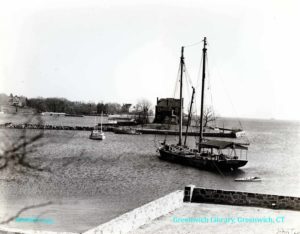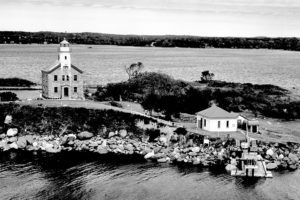Originally written by Carl White.
Photographer John Gotch
If you’ve followed my blog for any length of time, you’re probably familiar with the name John Gotch. John was a freelance photographer, who took pictures for the Greenwich newspapers. He had a studio on Lafayette Place called Town and Country Studios. This is where he took portraits. John donated his photographs and negatives to Greenwich Library and the Greenwich Historical Society when he retired. This has turned out to be a treasure trove for those researching local history.

John Gotch’s Early Years
John Gotch was born on Riversville Road on May 20, 1915. His family moved to 77 North Water Street in East Port Chester (or Byram, as it was later called after the war). This was near Grover Cunningham’s Body and Fender shop. The family then moved to the corner of Mill Street. His father bought the property and built a meat market and grocery store. Unfortunately, the Great Depression hit and the business suffered. His father had extended credit to many people, and they were slow in paying him back. This meant Mr. Gotch couldn’t pay the bills, and the business folded.
The Gotch family next moved to Pine Street, where they stayed with the Rowe family. There were many immigrants there including Germans, Italians, Slovaks, Polish, Hungarians, and Irish. These were very honorable and hard-working people.
When John was in the fourth grade, he was sent to a parochial school in Port Chester. He could walk instead of taking a bus or trolley. When he was 15 or 16, he worked for the A&P Store. John delivered groceries using an “Express Wagon.” People could get a wagon full of groceries for 15 cents. They didn’t have autos at this point. He used to get 10- to 25-cent tips.
John also worked as a “gopher”, running errands for the store. On Thursdays and Fridays, he would bag potatoes and sugar. He also pre-packaged butter, and ground-up coffee. When the store closed at 6 pm, he’d stay and clean up.
Family Life
Both John’s mother and father worked to support the family, so they weren’t at home. After school, John had to do chores, then do his homework. There were no community centers and the Town wasn’t yet offering any after-school programs. Open space was also disappearing, so there were few fields for athletic endeavors.
On Sundays, the family would go to church. Afterward, they would head to Byram Park for a Sunday lunch. There was usually a ballgame going on, or people would swim at the beach. There were shellfish boat slips, and sometimes fishing schooners would pull up. Part of the area was restricted as there were still men quarrying for rock. He and his friends would still crawl all over the quarry. Sometimes they would walk to Rye or Port Chester.
There was a Cygnet Club in Byram, which was an athletic club. It sponsored a baseball team and marathons. On Memorial Day, they would sponsor a race, and runners from Boston and New York City would participate. Local Bill Kennedy was a well-known runner.
There was even a circus on several occasions. A parade was held to promote the circus and featured a calliope, elephants, and giraffes. The circus staked its tents at Saunder’s Field at the foot of Byram Hill.
Interest In Photography
After John graduated from St. Mary’s in Port Chester, he went to Greenwich High School. He didn’t like to write. His English teacher was Andrew Bella. Bella told his students they could pass the class if they completed a project of their choice. So he borrowed the school’s telescope and a camera. Then he took a picture of the moon, which was quite impressive. Gotch’s reputation for photography began to grow.

Gotch decided he wanted to be a newsreel photographer. He was working at the Mill Street garage when a man offered to sell him a press camera for $100. John got a loan from the Byram Bank and was able to buy it.
Three or four months later, a major fire broke out on Greenwich Avenue, and Gotch was able to take pictures of burned-out houses and buildings. He took pictures of the Port Chester, East Port Chester, Cos Cob, Stamford, and Sound Beach Fire Departments all fighting the flames. Gotch had to hitchhike to White Plains to get the film developed. He had some pictures made into postcard-sized photos. The Greenwich News & Graphic agreed to buy his photos. Later the Daily Item enlisted him. He had to go to Yonkers to get the photos processed and sometimes didn’t arrive home until 2 or 3 in the morning.
War Breaks Out
As luck would have it, Greenwich Time advertised for a photographer. John applied for it and was offered the job. He worked there until the War broke out. Then he applied for defense work at Homelite. It wasn’t long before he joined the Navy. He was assigned to Naval Public Relations. At first, he was skipped over for a physical, but eventually, he took a physical and was classified as 4-F. He had to have an operation. This apparently changed his classification, as he spent 13 months in combat in the Pacific.
John came home and was assigned to 90 Church Street in New York City. He handled photography on the piers until he was sent to photography school in Pensacola FL. From there, he went to Norfolk VA to study aerial photography. His last year saw him passing through the Panama Canal, and being assigned to Navy Public Relations in Dallas TX. John was discharged in October 1945 from Long Island.
Post War Years
After the war, Gotch took a job in Manhattan, building and designing photography equipment. He did this for two years, then quit because he hated the commute. John decided to go into business for himself. It wasn’t long before he received an anonymous call, telling him to drive out to King Street. Here he found a cab and a dead cab driver, slumped over the steering wheel with a bullet hole in his head. Gotch contacted several major newspapers and sold the picture. This was the start of his notoriety. He started getting calls from all over for copies of his work. Gotch found out it was a policeman who was the anonymous caller.
When the Thruway was built in the 1950s, Gotch took pictures of the houses that were taken by eminent domain. It just so happened that they took away an embankment that people would use to park on and watch fireworks. When John Lodge and Abraham Ribicoff cut the ribbon for the Thruway, John took the picture. Ironically he remarked later that the highway was already “obsolete” and wouldn’t be able to handle future traffic.
Gotch covered a lot of local events. When an Army pilot accidentally dropped a flare on a restaurant on Great Captain’s Island that burned to the ground, he went out to cover it. He took pictures of the Rockefellers, the wedding of Desi Arnaz and Lucille Ball, and a photo of Ethel Skakel and Robert Kennedy leaving St Mary Church after their wedding. Olga Hirshhorn hired him to take pictures of her estate to make a book for her husband, Joseph Hirshhorn. Gotch was responsible for many of the photos that appeared in the Greenwich papers.
Retirement and Death
John Gotch retired about 1972. At this time, he donated his photos and negatives to the Greenwich Historical Society and Greenwich Library. Around 2008, I received a call from a nursing home in Florida, requesting that I send a few samples of his photos. I was happy to send several representative copies.
Recently I checked the AncestryLibrary database and learned John Gotch passed away on December 19, 2010, in Fernandina Beach, FL. Our town was lucky to have such a wonderful photographer record our history through pictures. He often said he didn’t like to write, but in his own way – through his photos – he said plenty. As the old adage says “a picture says a thousand words.”
SOURCE
Gotch, J.; John Gotch; Greenwich Library, Greenwich Oral History, Greenwich CT, 1987
ABOUT
Build your family tree, dive into the history of your historic home, and discover photos and articles of days gone past with the Library’s collection of 5,000 books, 800 Oral History transcripts, yearbooks, historical maps, vertical files, pamphlets, periodicals, and microfilm and microfiche. Plus, access resources like American Ancestors, AncestryLibrary, and more with a Library card. Learn more at greenwichlibrary.org/genealogy.
Get the latest about the Library’s History & Genealogy events and offerings sent to your email: greenwichlibrary.org/enews.
Questions? Contact:
Local History Librarian
(203) 622-7948
